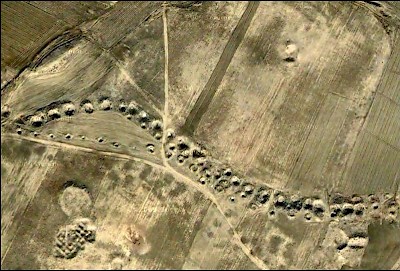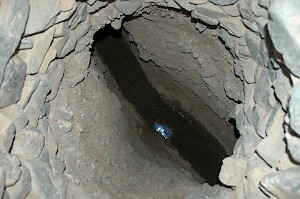Qanat
Qanat: type of underground irrigation canal between an aquifer on the piedmont to a garden on an arid plain. The word is Arabic, but the system is best known from Iran.

To make a qanat, one needs a source of water, which may be a real well, but can also be an underground reservoir (e.g., a cave with a lake) or a water-bearing geological layer, which can be recognized as a damp area in an otherwise arid region. When one has identified this source, a tunnel is cut to the farm or village that needs the water.

Shafts are added for three reasons: as air supply, to remove sand and dirt, and to prevent the tunnels from becoming dangerously long. The shafts are not very far apart, and as a result, a qanat seen from the air gives the impression of a long, straight line of holes in the ground - as if the land has been subjected to a bombing run.
Typically, the qanat becomes a ditch near its destination; in other words, the water is brought to the surface by leading it out of the slope. In fact, one creates an artificial artesian well and an oasis.

As the ceramics of the farms at the exit of a qanat offer an indication of its age, it is possible to date qanats. The technology became popular at the turn of the Bronze/Iron Age, about 1000 B.C.E., but is considerably older. In the late second millennium, there were qanats in the country that was once known as Maka and is now called Oman. In 2014, archaeologist claimed that a qanat, discovered near Iran's Seimareh Dam, dates back to the early third millennium.
In the sixth century, many qanats were dug in the area east of the Zagros mountains, and there is something to be said for the theory that the rise of Persis (under Cyrus the Great) and the fall of Media as the political center of Iran had something to do with the ability of the Persians to overcome a climatic change: the Persians, living in an arid zone, had learned to build qanats, and the inhabitants of Media (where rain-fed dryland cropping is possible) had not. It is perhaps no coincidence that the Greek researcher Herodotus of Halicarnassus in his description of the rise of Persia mentions agricultural activitiesnote and that the Achaemenid kings often presented themselves as gardener (roi-jardinier).
In the Persian Empire qanats appear to have spread along the Silk road to Parthia, Aria, Bactria, and Sogdia. Later, the technique became also known in Xinjiang. In the Roman age, we see the first qanats in Syria and Egypt, and the Muslim conquerors spread their use along the arid zone south of the Mediterranean. Today, qanats can be found as far west as Morocco and Andalusia, and even the Sicilian capital Palermo boasts a medieval qanat.
Being about 1½ meter high and ¾ meter wide, qanats are rather narrow, but they can reach depths of 30 meters (the record seems to be 60) and can cover distances of many kilometers (the longest Iranian qanat is said to be 70 kilometers long.) The trick is to make the angle of the qanat not too steep, because in that case, the water will grind itself down into the bottom and create pools that will make the qanat collapse; on the other hand, if the angle is not steep enough, the water will be tainted. Everything depends, therefore, on the correct angle. The diggers or muqannis were brilliant surveyors.

A qanat, once built, can exist for a long time, but agriculture with qanats is extremely labor-intensive. Not only is it difficult to dig an underground canal, but it also needs a visit every spring to clean it out. Usually, this work is left to boys, whose fathers are standing near the shaft and pull up buckets and can come to their children's rescue when the gallery collapses.
During the White Revolution of the late shah, Iran's great estates were broken up and the land was given to those who actually worked it. An unintended result was that it was no longer clear who was responsible for the maintenance of the qanats, and many fell into disrepair. At the same time, several qanats were replaced by underground canals made of concrete, which needed less maintenance and were cheaper. This process has accelerated during the last quarter of a century, but at least 20,000 qanats are still in use, and even those that no longer carry water are still useful - if only as traps for little animals.
In the Maghreb, qanats are called foggara; Moroccons call them khettara; the people of the Persian Gulf call them falaj; a Persian synonym is karez.